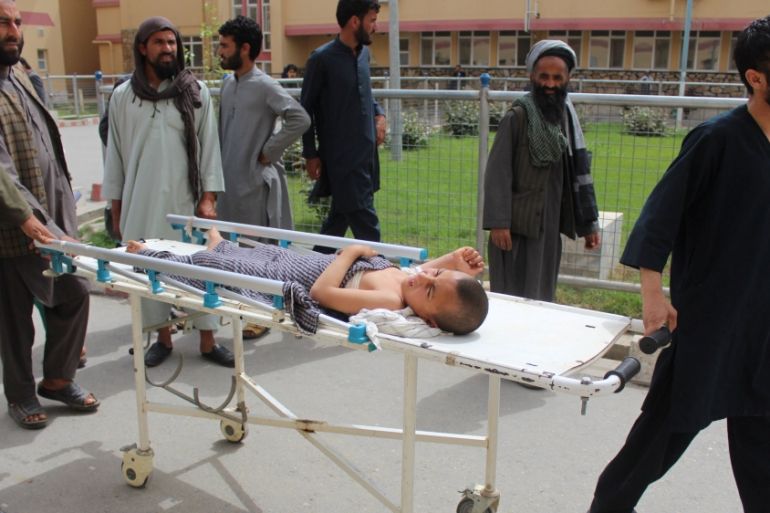Kunduz madrassa attack: Losing the moral high ground
The rising number of civilian casualties erode Afghan government’s moral high ground in its fight against the Taliban.

The attack by the Afghan government air force at the Hashemia Madrassa (religious school) in northern Kunduz province on April 2 that killed and injured scores of civilians and a number of Taliban fighters and commanders is, to paraphrase the late Colombian novelist Gabriel Garcia Marquez, a story of deaths foretold.
Last year, after the US government announced its (not so) new Afghanistan strategy, focusing on increased military pressure on the Taliban to force them to the negotiating table, the armed group replied in kind, announcing they would not be intimidated as they had sat out an onslaught of even larger troop numbers under President Barack Obama.
Keep reading
list of 4 itemsPhotos: Malnutrition threatens future Afghan generations
Photos: Tourist numbers up in post-war Afghanistan
Taliban ban on girls’ education defies both worldly and religious logic
To borrow a Pashto phrase, with that exchange of unpleasantries it was “clear as the sun” that, unfortunately, this year – since Nowruz on March 21 which is also the new Afghan year 1397 – would see another escalation of violence, pushing a breakthrough towards a negotiated end to this war further into the future. What Monday’s madrassa attack showed was that there is no end in sight to this conflict and both sides are willing to write off the deaths of the people they both insist to defend as “collateral damage”.
‘Wrong examples’
Unfortunately, the Afghans’ Western allies have repeatedly set wrong examples.
The most striking one was their denial, and then threadbare justification, of their bombing of a hospital run by Doctors Without Borders, known by its French initials MSF, in the very same embattled city of Kunduz in October 2015. The bombardment, conducted by the US-led, NATO driven Resolute Support Mission, killed 42 people, among them children, patients, MSF staff members and caretakers. The US acknowledged launching the air attack and admitted they “may have” hit the hospital, but tried to justify their actions by claiming that they were targeting “individuals threatening the force”. The Taliban’s declaration that they had no fighters present in the hospital, and the MSF statements that the “hospital’s coordinates were known to the US forces” fell on deaf ears.
Following Monday’s attack, the Afghan authorities followed the example their American allies set in 2015 and attempted to deny any wrongdoing. The Afghan Ministry of Defence’s spokesman, for example, insisted there were no civilians present at this madrassa at all – he claimed it was a “Taliban training centre”. It did not matter to Afghan authorities that almost at the same time the provincial governor’s spokesman announced that at least 5 civilians were killed and 55 were injured as result of the air attack.
Witnesses described how helicopters first shot and then fired rockets into a crowd largely consisting of minor religious scholars, their parents and teachers. According to witness accounts, the crowd was gathered outside the school not for a high-level Taliban meeting but a turban binding ceremony and lunch. According to civilian sources on the ground there were some Taliban commanders present, but they were only there to attend the ceremony and the lunch.
An Afghan pilot should have been able to recognise such a ceremony for what it is from a presumably low-flying chopper.
Mind you, even if a high number of Taliban commanders had been present, and even if they had held a war council there, hiding among civilians – firing at such a crowd does, according to the Geneva Convention, amount to the disproportionate use of force and possibly a war crime.
Yes, the Taliban, according to the UN, still cause more civilian casualties than the Afghan forces and their international allies.
In late January, they rigged an ambulance with explosives to attack an office of the Afghan interior ministry in Kabul and – when they failed to reach their target – blew it up opposite a large hospital in the morning rush hour, killing 95 people and injuring 158 others.
And a few days after Nowruz in Lashkargah, the provincial capital of southern Helmand, someone drove a car into a crowd leaving a sports stadium, killing and injuring dozens. The Taliban did not officially claim responsibility for this atrocity. But the local chapter of the Islamic State of Iraq and the Levant (ISIL, also known as ISIS) – which is the only other usual suspect – is not known to operate in Helmand, and would have said something if they were behind it. The bombing in Lashkargah came just two days after a suicide bomber detonated near Kabul University in the Afghan capital, killing 29 people and wounding 52 others. ISIL claimed responsibility for that attack.
In contrast, forces fighting these groups under the leadership of the Resolute Support Mission and the Afghan forces that they train should hold themselves to a higher standard.
Forces representing democratic countries in Afghanistan, and their Afghan allies, should make sure to hit their targets without killing innocent civilians, or in their words, “causing any collateral damage”. They should abide by the Geneva convention and avoid launching attacks on civilians, even when “high value targets” are believed to be among them.
If this does not become an unbreakable rule, Afghan government forces can not gain the moral high ground and distinguish themselves from the groups that they call “terrorists”.
The views expressed in this article are the author’s own and do not necessarily reflect Al Jazeera’s editorial stance.
